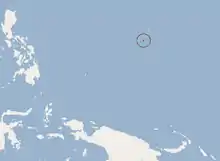Guam flying fox
The Guam flying fox (Pteropus tokudae), also known as the little Marianas fruit bat, was a small megabat from Guam in the Marianas Islands in Micronesia that was confirmed extinct due to hunting or habitat changes.[1] It was first recorded in 1931 and was observed roosting with the larger and much more common Mariana fruit bat. The last specimen was a female found roosting at Tarague cliff in March 1967, but it escaped capture. An unconfirmed sighting took place sometime during the 1970s, and no other individuals have been sighted since then.[1]
| Guam flying fox | |
|---|---|
| Scientific classification | |
| Domain: | Eukaryota |
| Kingdom: | Animalia |
| Phylum: | Chordata |
| Class: | Mammalia |
| Order: | Chiroptera |
| Family: | Pteropodidae |
| Genus: | Pteropus |
| Species: | †P. tokudae |
| Binomial name | |
| †Pteropus tokudae Tate, 1934 | |
 | |
Description
The Guam flying fox had a length of about 15 cm (6 in), a wingspan of about 70 cm (28 in), and a body weight of 152 g (5.4 oz). It was very similar in appearance to the Chuuk flying fox (Pteropus insularis). The top of the head was greyish, the back, throat and underparts was brown or dark brown, and the side of the neck was golden-brown.[3]
Behaviour
Little is known about the behaviour of this flying fox, but it is likely that it fed on the fruits, flowers, and foliage of evergreen shrubs and trees that are characteristic of the limestone forests found in the northern part of Guam. Similarly, not much is known about its reproductive habits, but an incident in 1968, where a female was shot, revealed that she was accompanied by an immature individual. This suggests the possibility of ongoing parental care.[3]
Status
There are no confirmed records of sightings of this bat since the 1970s and the IUCN lists it as being "Extinct". When it was more plentiful it was hunted by humans for food, which may have contributed to its extinction. Another factor may have been the introduction, into the island, of the predatory Brown tree snake (Boiga irregularis).[1] In September 2021, the U.S. Fish and Wildlife Service officially declared the species extinct and was delisted in October 2023 with accordance to the Endangered Species Act.[4][5]
Footnotes
- Bonaccorso, F.J.; Helgen, K.; Allison, A.; Wiles, G. (2020). "Pteropus tokudae". IUCN Red List of Threatened Species. 2020: e.T18763A22088402. doi:10.2305/IUCN.UK.2020-3.RLTS.T18763A22088402.en. Retrieved 11 November 2021.
- "Endangered and Threatened Wildlife and Plants; Removal of 23 Extinct Species From the Lists of Endangered and Threatened Wildlife and Plants". www.regulations.gov. Retrieved 2022-06-13.
- Jeffery Rebitzke (2002). "Pteropus tokudae: Guam flying fox". Animal Diversity Web. University of Michigan. Retrieved 2013-12-29.
- "U.S. Fish and Wildlife Service Proposes Delisting 23 Species from Endangered Species Act Due to Extinction". United States Fish and Wildlife Service. September 30, 2021. Retrieved September 30, 2021.
- "21 Species Delisted from the Endangered Species Act due to Extinction | U.S. Fish & Wildlife Service". FWS.gov. 2023-10-16. Retrieved 2023-10-17.
References
- Flannery, Tim and Peter Schouten (2001). A Gap in Nature. Published by William Heinemann
